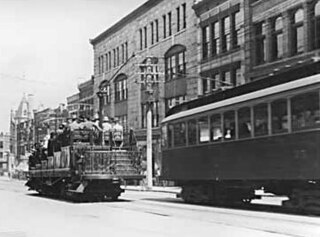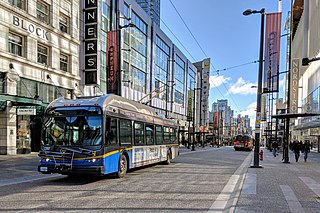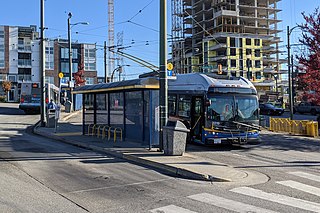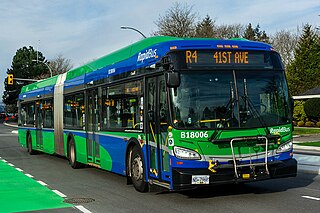
TransLink, formally the South Coast British Columbia Transportation Authority and previously the Greater Vancouver Transportation Authority, is the statutory authority responsible for the regional transportation network of Metro Vancouver in British Columbia, Canada, including public transport, major roads and bridges. Its main operating facilities are located in the city of New Westminster.

The British Columbia Electric Railway (BCER) was an historic railway which operated in southwestern British Columbia, Canada. Originally the parent company for, and later a division of, BC Electric Company, the BCER assumed control of existing streetcar and interurban lines in southwestern British Columbia in 1897, and operated the electric railway systems in the region until the last interurban service was discontinued in 1958. During and after the streetcar era, BC Electric also ran bus and trolleybus systems in Greater Vancouver and bus service in Greater Victoria; these systems subsequently became part of BC Transit, and the routes in Greater Vancouver eventually came under the control of TransLink. Trolley buses still run in the City of Vancouver with one line extending into Burnaby.

The Millennium Line is the second line of the SkyTrain rapid transit system in the Metro Vancouver region of British Columbia, Canada. The line is owned and operated by BC Rapid Transit Company, a subsidiary of TransLink, and links the cities of Vancouver, Burnaby, Coquitlam and Port Moody. The line was opened in 2002 and was named in recognition of the new millennium.

The Canada Line is a rapid transit line in Greater Vancouver, British Columbia, Canada, that is part of the SkyTrain system. The line is owned by TransLink and InTransitBC and is operated by ProTrans BC. Coloured turquoise on route maps, it operates as an airport rail link between Vancouver, Richmond, and the Vancouver International Airport (YVR). The line comprises 16 stations and 19.2 kilometres (11.9 mi) of track; the main line runs from Vancouver to Richmond while a 4-kilometre (2.5 mi) spur line from Bridgeport station connects to the airport. It opened on August 17, 2009, ahead of the 2010 Winter Olympics.

Metrotown is an elevated station on the Expo Line of Metro Vancouver's SkyTrain rapid transit system, and is located along Central Boulevard, directly across from the Metropolis at Metrotown shopping centre, in Burnaby, British Columbia, Canada. As of 2022, it is the second-busiest station in the SkyTrain system.
BC Transit is a provincial Crown corporation responsible for coordinating the delivery of public transportation within British Columbia, Canada, outside Greater Vancouver. BC Transit is headquartered in Victoria, British Columbia. In 2023, the system had a ridership of 26,377,500, or about 98,100 per weekday as of the second quarter of 2024.

Coast Mountain Bus Company (CMBC) is the contract operator for bus transit services in Metro Vancouver and is a wholly owned subsidiary of the South Coast British Columbia Transportation Authority, known locally as TransLink, the entity responsible for public transit in the region. The buses form part of the integrated transit network of the Lower Mainland.

Surrey Central is an elevated station on the Expo Line of Metro Vancouver's SkyTrain rapid transit system. The station is located in the Whalley / City Centre district of Surrey, British Columbia, Canada, just east of the North Surrey Recreation Centre. The station is within walking distance of the Central City shopping centre, Surrey City Hall, and SFU Surrey, the Surrey campus of Simon Fraser University.

The Vancouver Downtown Historic Railway was a heritage electric railway line that operated from 1998 to 2011 between Granville Island and Science World, in Vancouver, British Columbia, Canada. It operated only on weekends and holidays, usually from May to mid-October, and was aimed primarily at tourists. Two restored interurban trams were used on the line, which used a former freight railway right-of-way.

The Granville Mall is a transit mall and pedestrian zone in Vancouver, British Columbia, Canada. It comprises the section of Granville Street in Downtown Vancouver between Hastings and Smithe streets. Most routes that service the mall are primarily trolleybuses operated by TransLink; in addition to bus service, the Granville Mall can be accessed by SkyTrain from either Granville and Vancouver City Centre stations of the Expo and Canada lines, respectively.

The 98 B-Line was a bus rapid transit line in Metro Vancouver, British Columbia, Canada, that began service in September 2000. It linked Richmond to Downtown Vancouver, with a connection to Vancouver International Airport. It travelled mainly along Granville Street in Vancouver and a dedicated bus lane on No. 3 Road in Richmond. It was operated by Coast Mountain Bus Company and was funded by TransLink. The route was 16 kilometres (9.9 mi) long. The line carried over 18,000 passengers daily. It was discontinued in September 2009, shortly after the opening of the Canada Line, which replaced it.

The 99 B-Line is an express bus line with bus rapid transit elements in Metro Vancouver, British Columbia, Canada. It travels along Broadway, a major east–west thoroughfare, and connects the University of British Columbia (UBC) to Commercial–Broadway station on the SkyTrain system. It is operated by Coast Mountain Bus Company and funded by TransLink.

Airport station was a TransLink public transit exchange on Sea Island, Richmond, in Metro Vancouver. Most bus operations using the location ceased September 7, 2009, two and a half weeks after the opening of the Canada Line, when the exchange downgraded to a regular bus stop.

Marine Drive is an elevated station on the Canada Line of Metro Vancouver's SkyTrain rapid transit system. The station is located at the intersection of Cambie Street and SW Marine Drive in Vancouver, British Columbia.

The Marpole CP Rail Bridge was a partially dismantled crossing over the north arm of the Fraser River, and River Dr., in Metro Vancouver.

Phibbs Exchange is a major transit exchange in the District of North Vancouver, British Columbia. Part of the TransLink system, it is home to routes serving the North Shore and provides connections to the cities of Vancouver and Burnaby. Opened on October 19, 1973, it is one of the four major transit exchanges on the North Shore. The exchange is named after Charles J. P. Phibbs.

Kootenay Loop is a transit exchange in Vancouver, British Columbia, Canada. It is the easternmost major transit exchange in the city of Vancouver, with routes serving Vancouver, Burnaby, North Vancouver and the Tri-Cities.

The R4 41st Ave is an express bus route with bus rapid transit elements in Metro Vancouver, British Columbia, Canada. Part of TransLink's RapidBus network, it replaced the 43 Express that travelled along 41st Avenue, a major east–west route that connects the University of British Columbia (UBC) to the SkyTrain system's Oakridge–41st Avenue station on the Canada Line and Joyce–Collingwood station on the Expo Line.

Brighouse is a neighbourhood that comprises most of the urban core of Richmond in Metro Vancouver. The area includes community facilities, civic offices, Richmond Centre, and the Canada Line Richmond–Brighouse station terminus.

The Vancouver trolley bus system forms part of the TransLink public transport network serving Metro Vancouver in the Canadian province of British Columbia. Opened in 1948, the system was originally owned and operated by the British Columbia Electric Railway. By 1954, Vancouver had the largest trolley bus fleet in Canada, with 327 units, and the fleet grew to an all-time peak of 352 in early 1957. There were 19 routes by 1955 and a peak of 20 by the second quarter of 1957. The last route to open in the 1950s was the only express trolley bus service that ever existed in Canada. Several, mostly short, extensions to the system were constructed in the 1980s and later.




















